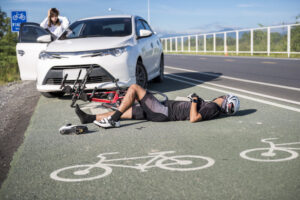Bicycles are an excellent form of transportation and exercise, with millions of Americans using them daily to get to and from various places or to get a workout in. As more people rely on bicycles to get somewhere or use them as a form of sport, there are bound to be more bicycle accidents.
Many of these accidents result from ever-growing distractions for vehicle owners because of technology. Still, they can also occur for reasons that have nothing to do with smartphones or electronic distractions.
In the end, most bicycle accidents happen because of negligent drivers. All of the other reasons are just subcategories of negligence.
We discuss some of the most common causes of bicycle accidents in the material below. If you have suffered injuries in a cyclist accident, contact a bicycle accident attorney as soon as you can.
Speeding
As with other types of crashes, speeding is one of the most common causes of bicycle accidents. Whether it’s with a car, truck, motorcycle, ATV, or any other motor vehicle, speeding can be extremely dangerous for any bicyclist unlucky enough to be around. The faster a vehicle goes, the harder it is to stop, and the less reaction time the driver has, increasing the risks of a collision. The greater the speed, the greater the risk of severe injuries to bicyclists.
Distracted Driving
These days, it’s not uncommon to spot a driver using their phone, putting makeup on, or even having a meal. According to the National Highway Traffic Safety Administration (NHTSA), those that eat and drive can increase the chances of an accident by 80 percent.
With the constant stress from their jobs that Americans face every day, they also find themselves constantly replying to emails, jumping on calls, and texting their colleagues while they drive to save time. Every day, nine people die because of distracted driving, a fifth of whom are not even in vehicles but were bicyclists and pedestrians. The consequences can be disastrous whether a distraction is cognitive, manual, or visual.
Illegal or Unsafe Lane Changes
Drivers sometimes make illegal or unsafe lane changes and maneuvers to get ahead of traffic. Unfortunately, they may not realize that a bicyclist may be in the next lane and moving even slower than the traffic around them. Making sudden and careless lane shifts can be very dangerous for bikers. In addition, some drivers may veer into dedicated bike lanes due to distraction or even in an attempt to pass the vehicles in front of them.
Failure to Yield
Whether out of impatience or distraction, many bicycle accidents occur at roundabouts, intersections, or other places where a vehicle must yield to a bicyclist. The number of drivers on the road today who are unaware of yield rules is very alarming. Sadly, many drivers need a refresher on yielding rules. Failure to yield from the car operator’s part is the second most common cause of bicycle-car accidents, with 51 percent occurring at an intersection.
Failing to Stop at a Stop Sign or Stoplight
Not stopping at a stop sign or red light is another widespread and unfortunate reason for many bicycle accidents that can cause serious injuries. These accidents often happen when a driver believes they have time to “beat” a yellow light, so they speed up. If a bicyclist who is crossing the street is already preparing to go, the light may turn green for the bicyclist before the car can cross.
When this occurs, it can result in serious and even fatal T-bone collisions between bicyclists and vehicles. This outcome can also occur in rural areas when drivers do not believe they do not need to stop since there are no other cars around. They may not see a bicyclist about to cross and hit them because they thought it was safe not to run a stop sign.
Failure to Provide Enough Space
Under many state and local laws, drivers must give bicyclists a certain amount of space. Unfortunately, drivers do not always follow these laws, putting cyclists at risk. When drivers do not allow enough of a buffer between them and bicyclists, they risk running into them. When drivers cannot give cyclists adequate room, they must slow down and wait until they can pass them.
Changing Direction Without Checking
In some cases, bicycle accidents occur when drivers suddenly decide to change directions while they are at intersections or roundabouts. A driver might make a U-turn or swerve because they missed an exit or turn. In making such a hasty choice, a driver might notice a bicyclist near them and cause an accident.
Driving Under the Influence
 When a driver is under the influence of alcohol or drugs, they put everyone around them at risk—especially cyclists. Alcohol is a depressant, which will slow down the functions of the nervous system. It causes the driver to relax, feels sleepy, has impaired vision, and suffer other effects that can lead to serious accidents. Alcohol can also make it difficult to understand what is happening around a driver and result in overconfidence, leading to poor decisions on the road.
When a driver is under the influence of alcohol or drugs, they put everyone around them at risk—especially cyclists. Alcohol is a depressant, which will slow down the functions of the nervous system. It causes the driver to relax, feels sleepy, has impaired vision, and suffer other effects that can lead to serious accidents. Alcohol can also make it difficult to understand what is happening around a driver and result in overconfidence, leading to poor decisions on the road.
With just a blood alcohol content (BAC) level of 0.02 percent, equivalent to one drink, a driver can feel dizzy and drowsy and make poor decisions. Even the slightest swerve from a driver driving under the influence can result in a bicyclist suffering a great deal of injury.
Dooring Accidents
Many bicyclists can suffer injuries from incidents often seen in movies and cartoons: the driver swings their car door wide open while parked or stopped, and the bicyclist going by crashes into it. While dooring accidents are often used humorously, in reality, there is nothing funny about them.
Bicyclists often travel at high speeds, so when a door opens quickly in front of them, they do not have time to stop or get out of harm’s way. In many cases, dooring accidents lead to serious injuries for cyclists.
One in ten accidents involving bicyclists and cars happens because of a car door opening. It can lead to minor or severe injuries for the bicyclist. With hundreds of cities across the nation having heavy traffic, hundreds of buildings, and parallel parking spots, it’s easy to imagine dooring accidents happening fairly often.
Driver Fatigue
When drivers get tired, they can make bad decisions. Fatigue often leads to drivers reacting more slowly to changing road conditions or traffic, drifting from their lanes, and experiencing tunnel vision, where the drivers lose the sense of their peripheral vision. They can even forget the last few miles they drove and can enter periods of microsleep, where they fall asleep for a few seconds. Thirty-seven percent of U.S. workers sleep less than seven hours every night. Driver fatigue is just as dangerous and deadly as driving impaired by alcohol or drugs.
Blind Spots
Many drivers have significant blog spots that depend on their car’s design, the driver’s height, and how vigilant they are in checking those areas. Since bicycles are smaller than cars, they are easier to miss when checking the blind spot.
So, when a driver tries to make a turn or change lanes and does not pay close attention, they can hit a bicyclist and cause serious harm. Blind spot accidents can happen, especially with commercial truck drivers, since they have more and larger blind spots than passenger vehicles.
Rear-End Collisions
Rear-end collisions are one of the most common types of car-bicycle accidents. The League of American Bicyclists reports that 40 percent of all fatal crashes involved a bicyclist hit from behind. Rear-end collisions endanger bicyclists because while a car has seatbelts and airbags, cyclists have nothing to prevent them from flying off their bikes.
Rear-end accidents can easily eject bikers from their seats and send them crashing into the ground – or worse, if the car is coming at high speeds, it can run them over, depending on how they fall. The crash can propel them onto the car’s windshield, resulting in several injuries. It takes a lot of force to break the windshield glass, but with this type of collision, it can happen.
Aggressive Driving
Aggressive driving is an epidemic in the United States. Of the country’s five million car crashes every year, over 50 percent result from aggressive drivers. Aggression can involve a number of dangerous behaviors, including speeding, cutting others off, flashing high beams, or tailgating.
It is particularly dangerous when aggressive driving targets cyclists and cyclists should do as much as possible to prevent a situation from escalating. Still, some people’s unpredictable behavior can make reactions in the heat of the moment difficult.
Debris on the Road
Encountering debris on the roadway that fell from a car or truck can pose a considerable risk to bicyclists. Hitting debris on the road can be out of their control if another car hits the debris, causing it to get in their way. They can lose control of their bicycles and crash, leading to grave injuries. If a bicyclist crashes because of debris in a bustling and high-traffic area, there can be a more catastrophic outcome if there is a secondary collision between the cyclist and another vehicle.
When Are Bicycle Accidents Legally Actionable?
Bicycle accidents happen for a wide variety of reasons, but not all of them entitle victims to compensation. Under the law, to recover compensation for an accident, your accident must have resulted from someone else’s negligence. Negligence occurs when a person fails to use the degree of care that a reasonable person should ordinarily exercise, and an accident occurs as a result.
Most of the reasons listed above will almost certainly amount to driver negligence in most instances. That said, there are exceptions. For example, if a driver had a medical emergency at the time they ran a stop sign, they may not be liable for any injuries they caused. The most effective way to find out if you can file a claim after an accident is to have your case reviewed by a bicycle accident lawyer.
An attorney can identify any at-fault parties, determine how much your claim is worth, and attempt to negotiate a settlement with the insurance company. In the event that your lawyer cannot get the insurance company to make a reasonable offer, they can file a claim and represent you in court.
Do You Need a Lawyer to Recover Compensation?
You always want to hire a bicycle accident attorney to handle your injury claim. Trying to take on the insurance company alone can leave you with much less compensation than you deserve or even with nothing at all. Insurance companies want to avoid paying claimants whenever possible, as it protects the company’s bottom line. This is often true no matter how severe your injuries and losses might be.
First, insurers might deny that their policyholder was to blame. This allows them to avoid any liability for your losses. You will need to present sufficient evidence of liability, which can require in-depth investigation. A bicycle accident attorney knows how to handle this process and understands what evidence will be persuasive enough to prove liability.
Even if an insurance adjuster concedes liability, they will likely underestimate your losses and make a settlement offer that is far lower than you deserve. Never accept a settlement offer without having an attorney review it first. If you accept an inadequate amount, you cannot go back and ask for more once you realize the mistake. Your acceptance is usually final, so always get legal advice before signing anything or accepting a check.
Insurance companies use many tactics to reduce payments, and it is all too easy to say the wrong thing to an adjuster. You might not realize you said something until they are using it against you to limit your settlement. The best move is to hire an attorney from the start of the process and allow them to handle all communications with the insurers.
A skilled bicycle accident lawyer will negotiate for a fair settlement and take your case to court if insurers are uncooperative. The right legal representation is an invaluable resource that regularly increases the compensation that victims take home.




















